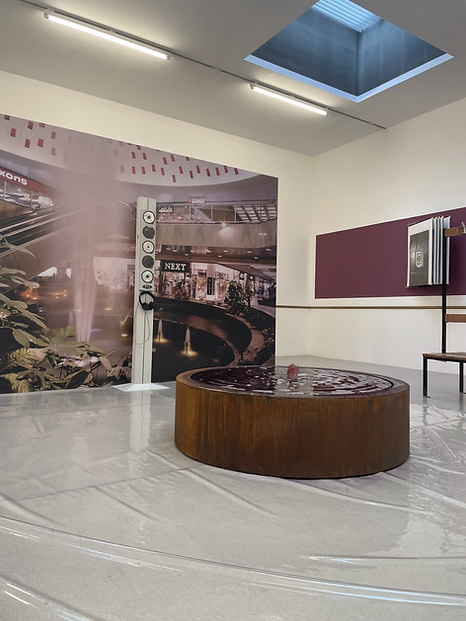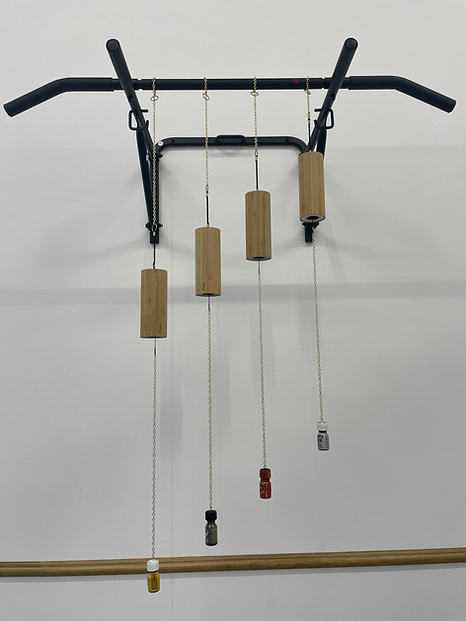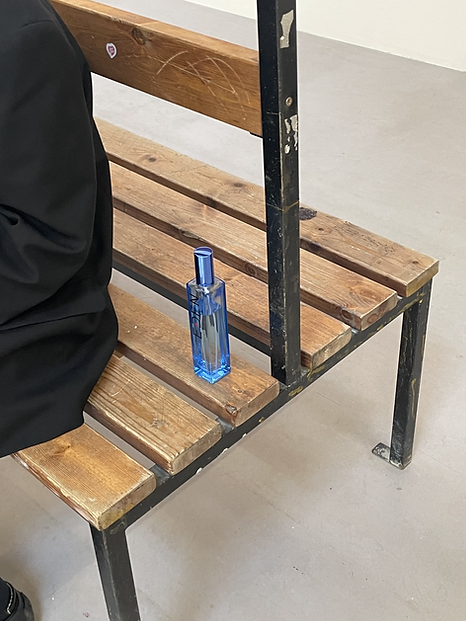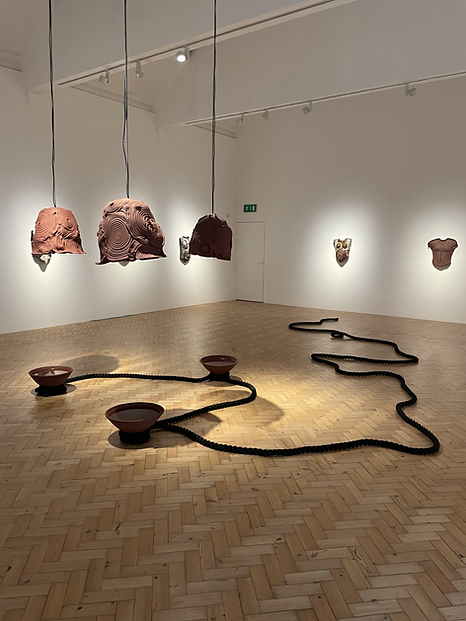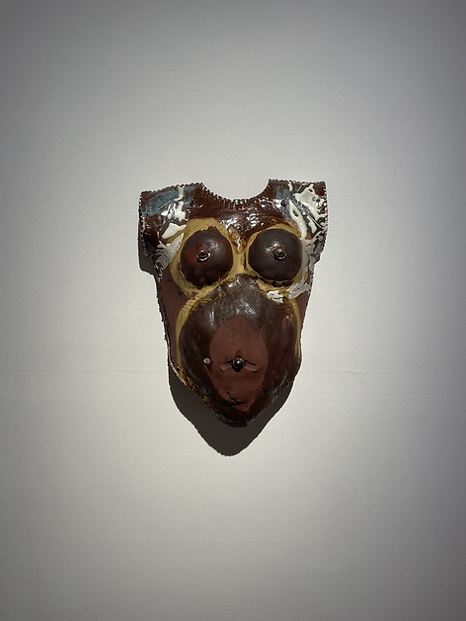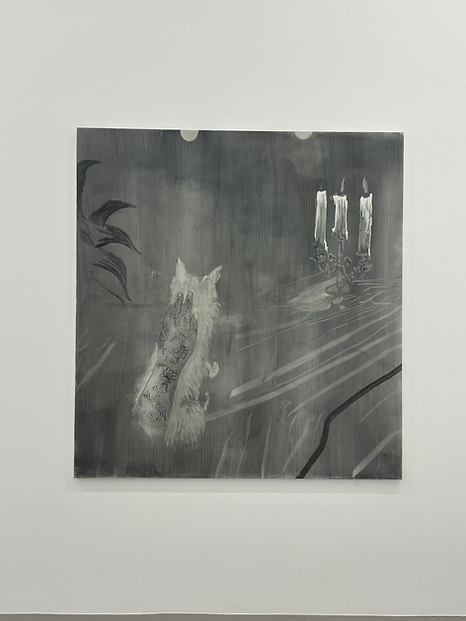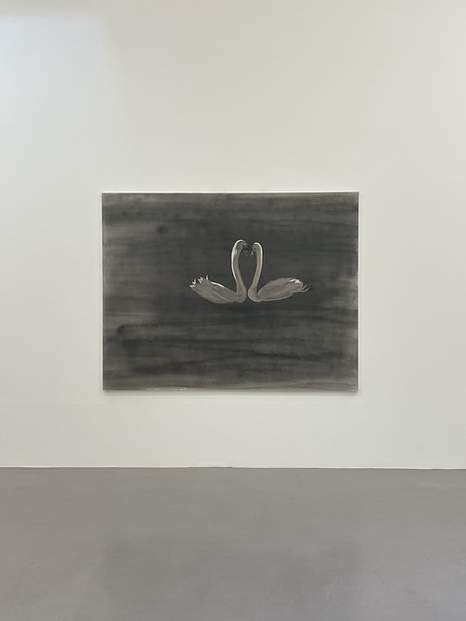3 for 1 at Camden Art Centre: Adam Farah, Phoebe Collings-James & Zeinab Saleh
Emoji summary: 💧 ⛰ ☁️
It looked sunny when I left the house but by the time I got to Camden Art Centre the clouds were low and grumbling. 3 shows in 1 place: Adam Farah, Phoebe Collings-James & Zeinab Saleh. I am a sucker for a bargain, even if these are 3 artists that feel far apart at first glance. Let’s go through them all and then circle back for a debrief.
Call me crazy but I can tell that Adam is a Capricorn. It’s palpable; grounded in the earth and place, the specific lingering melancholy of being and inhabiting. This is the first room I walk into. First hit when you reach the doorway: a maroon wall, a print in a neat black frame, dark pink and purple, hazy and open. The maroon wall continues in a loop of the gallery wall but it’s only a thick strip at eye-level. Beneath it there’s a thin dado rail. The stained wood feels settled against the matte white gallery wall, like a gentle limit (brace or clip). Around this outer limit there are posters: Mariah Carey’s Rainbow album cover art, yellow tape on the 4 corners. Mariah’s body is glossy and golden and taut. There are posters in those little flip folders, the kind they used to have in HMV, hoisted up against the wall too. Mirror selfies of Adam taken on one of those old Nokias, the 7600, shaped like a leaf or the imprint of the palm of a hand closing gently. That and more, camera roll crumbs, images that are slight or askew.
I find it difficult to meet the eye of the middle of the space. But it’s bracketed by the two inner walls, blocking off the doorway and closing in. There’s a cream carpet wrapped in plastic and a circular fountain. The outer edge of the fountain is metal and rusted, the liquid looks dark and the jet shooting out of the middle is only a small burst but it looks dark red and warm. The handout lists KA Grape soda as a material. On one wall there’s a screen with footage from a helmet cam, Adam cycling along an overpass. On the other side the standing wall is covered by a large print of a shopping centre interior. It looks familiar but it’s too old for me to place it, I go home and google ‘Brent Cross 80s’ and it’s the second image to come up. I didn’t recognise it because they got rid of the domed mosaic roof and the fountain in 1995, a year after I was born, but still the shape and the layout feels familiar. In front, a CD tower, like they used to have in HMV. You know the ones with the CDs already loaded so you can listen through, with headphones hooked up. I thought they were a fever dream because the past always feels unreal and I don’t remember them being that tall. Two PE changing room benches make a perfect enclosure. There’s a little green and yellow FREE YARD sticker (like the old lime wire logo) stuck on the side. Behind the back wall there’s a tight corridor with sculptures hung up on the wall above the dado rail. Poppers on gold chains in a cascade, like wind chimes hanging from pull up bars. On my way out I see a blue bottle of aftershave on the seat of the changing room bench. I sidle up to the gallery attendant and she tells me it’s part of the show. I pull my mask down past my nose and all of a sudden I can smell it. I can never identify the component notes of perfume, I don’t know what differentiates woody tobacco citrus or leather. But smell is so intimate and personal. Whatever it conjures, I get the feeling it isn’t for us. We sit within it, simmering, all the same.
Next is Phoebe Collings-James. There’s a change of pace and mood and I shudder as I pass through this drop. Adam’s room was heightened by wave after wave of emotional touchpoints, but Phoebe presents something sparse and clean. Spotlights shine on a series of ceramic breastplates hung along the wall. Like suits of armour, but still breakable. They’re not fragile though, some are these solid weighty lumps and I can see the earthy-ness in their heft. Some look battered and bruised, body as remnant, or proxy for the body. Some are glazed and smooth, the bellies and breasts round and plump like bagels against the plastic of their wrapper. Some are sweet and small, with little nipples, pierced and erect. In the middle of the room, a thick black rope twists and trails across in a V shaped pinch. On one end, the rope coils around on itself and 3 flat wide bowls are balanced into the crevice. They are full of still water. When I walked round, there was a kind of music playing into them, from 3 deep cups hanging from above. The bowls and the cups are all too large to fit in a hand, but I want to put my head into them and feel them against my body all the same. Across the other walls there are slabs and tiles, marked with violent sweeps and crackling surfaces. The handout makes reference to a bunch of things that I don’t really feel in the room with me: about tenderness, story-telling, poetry, sensuality, broken-heartedness and desire. All I feel is the weight of the bodies and vessels around me, this earthy heft heavy on my eyes and my mind. I want to be underground, swallowed whole by the earth beneath me and speeding away from daylight. Ceramic processes are so opaque to me though. I walk around and I feel like whatever’s going on is just happening at a register slightly above my head, like it is far away or behind a pane of glass.
Through a doorway and into a side room, the light lifts. Zeinab Saleh’s paintings are against a backdrop that’s even cleaner and sparser. It’s like mood is dropping off me as I move through the spaces. If Adam and Phoebe’s rooms were earthy and grounded, Zeinab’s is smoke and air, reflecting light. Neatly hung canvases on bright white walls, muted colour, smooth gesture and implication. The handout tells me the drawings are layered charcoal, swept over the surface with a broom or a brush. Marks have been made by removing the charcoal, masking parts off, body and movement. These works feel physical and ever so slight. A hennaed hand reaches out to stroke the back of a cat, a dove and a snake bordered by tassels, a mirror by a window in the moonlight, a lily open and waiting, two swans on the brink of a kiss. Where Adam deploys careful feeling, Zeinab’s work is a sprawling, leaking mood. RnB slow jams, lo-fi, it moves slower and smoother, but it is an open pore. Even if the title rests heavy on softness, these are all images with a kind of quietness and solitude. They feel like they’re waiting or on pause.
Full disclosure: Zeinab was our August web resident this year, some of the works were familiar from our own homepage. So I’m biased, I obviously like them. And I was glad to see Adam work on this scale: fuller and louder, unfurling across an entire room without interruption or containment. I’ve only ever seen Adam’s work in snippets and isolated moments, in group shows or on instagram. On this new scale, as the only voice in the room and recipient of my full and complete attention, the work felt really mature and skilfully handled, like it all just clicked and fell into line. I like the work of all 3 of these artists, but something about the order and scale of how I saw things made me trip over myself as I walked through it in this order and at this pace. Maybe I should’ve gone through the order backwards and built up the pace rather than have layers peel off me as I moved? But probably, as usual, this is something curatorial and on the scale of an institution. Artists can only use the space that’s cleared for them, they are limited by the gallery walls around them.
This was 3 shows on in 3 separate rooms, right next to each other and at the same time. I don’t think it should have been. Maybe I want 3 separate solo shows, on at different times, with use of all 3 rooms across the upstairs galleries. Or maybe I want a proper group show with these 3 artists, all their work touching and stepping over each other through the 3 rooms like messy collaboration. This separation and smallness doesn’t make sense to me. It isn’t because Adam, Phoebe and Zeinab are makers far apart from each other, having distant and different conversations. There’s a collaborative public programme attached to these 3 shows, so there’s the potential for overlap between them and beyond. And it’s also not because these shows were bitesize and small by design. There were sparse moments but the mood felt consistently crammed, like the artists were bordered in by the walls around them, dictated to by the space rather than conjuring it for themselves with mastery of it.
I can’t put my finger exactly on what it all ~should~ have been, and I’d bore you by listing the possibilities. But I think the decision to not put on 3 separate solo shows is racialised. I don’t say that lightly, I say that knowing the value and weight of these 3 artists in their own right, and their value and weight to Camden Art as an institution looking to hit their ~charitable goals~.
The decision to put on all 3 shows separately and at the same time made my experience of the work suffer. I was thrust through moods and paces that didn’t fit, that were discordant. I’m mentioning it carefully in this review mostly because I feel bad about it all. Something in my gut makes me feel like the artists have been hard done by with the arrangement as it is, and it is a shame that the work suffered because of it. But I think it’s worth mentioning because this doubling/tripling up artists of colour, cramming them into a space you’d normally give to 1 artist (if they were white), seems to be emerging as a pattern. When I sent this text to Gab for proofreading, she mentioned the Bluecoat’s current show(s): a triple bill of Deborah Roberts, Rosa-Johan Uddoh and Sumuyya Khader. These 3 artists are also crammed into the space the Bluecoat would normally happily hand over to 1 white artist, billed as solo shows. I FEEL BAD. Part of me hates mentioning it because I love these artists, I want to see them flourish and win and do well. I want more for them than these institutions are giving so I can’t skip over the glaring fact that there’s been a contraction of the space artists of colour have access to. The weird and jarring feeling lies with Camden Art, their organisational and curatorial decisions, and what the art world at large feels is acceptable treatment for artists of colour.
There were 3 solo shows in the space of 1, where curatorial opportunities to pull them together, or just follow them through, were missed. I think in my descriptions, maybe these opportunities appear visible, but I think that’s the point of critics (lmao). I get to do my homework with hindsight, I can follow the threads I wish had been chased by the curators. I can also describe the work as lovingly as possible in the hope you’ll get a sense of the work and its beauty, away from the problems and the space. In person, these were 3 shows in 3 separate small boxes. I enjoyed my time in each, but it’s not fair that they were contained and made small. I wish they’d been allowed to leak over into each other, or given the space to leak over alone.
Adam Farah, Phoebe Collings-James and Zeinab Saleh's shows are all on at Camden Art Centre until 23rd December.
